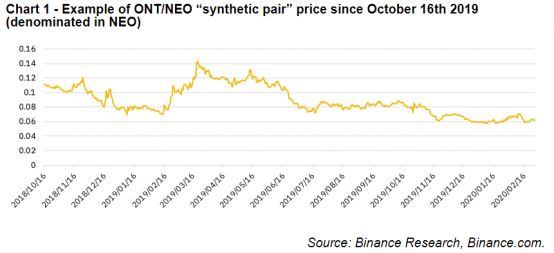Case study: How to create a synthetic trading pair?
Editor's note: The original title was "Case Study: Creating a Synthetic Trading Pair"


1.1 Trading with margin
- Borrow assets to short: mortgage USDT and borrow into NEO;
- Sell the asset to get the quote currency: sell NEO to get the corresponding amount of USDT;
- Use the quote currency to make another asset long: Use the USDT held to buy a corresponding amount of ONTs.
- Borrowing quote currency: mortgage NEO and borrow USDT;
- Use the quote currency to be long on another asset: buy the corresponding amount of ONT from the USDT held.
1.2 Use of Derivatives
- Sell NEO / USDT contract;
- Buy an ONT / USDT contract with the same NEO / USDT contract quota as the one sold.

- Higher price efficiency in the market: By combining a put / bullish view relative to two assets, traders can more easily hold positions based on their strategy, that is, improve market efficiency.
- Additional trading opportunities: From a user's perspective, this combination of long and short positions will better enable traders to maintain a market-neutral attitude. Because digital assets often show high correlation, it prevents "single market" bets in a single direction.
- Profit and loss can be achieved in the quote currency: a trader can bet on changes in the price of two assets while achieving profit or loss in the quote currency (such as USDT).
- Additional fees (compared to regular spot transactions)
- For perpetual contracts: Since the position involves twice as many transactions as a normal position, a fee must be paid twice. In addition, funding rates may result in additional costs (but may also be additional income).
- For margin trading: Positions can involve up to three times the number of transactions. In addition, interest must be paid on the borrowed assets, which can greatly affect the effectiveness of the strategy.
- However, this synthetic trading pair can promote market liquidity, resulting in higher spreads (which may be higher than the stated transaction costs).
- Liquidation risk
- For perpetual contracts: The short end of the transaction may cause users' liquidity problems. Because we are using a third-party currency (such as USDT) that is not related to the two currencies involved in the synthetic trading pair.
- For margin trading: different from spot trading: if the price movements differ greatly from the expectations corresponding to the positions established, then the strategy faces the risk of being liquidated.
- Managing this position will be more complicated
- For perpetual contracts: In the case that the financing rate is received or paid every 8 hours, it must be properly handled to ensure the balance between the two ends of the strategy.
- For margin trading: In the long term, there is a very obvious cost to maintaining this position. Due to the existence of borrowing interest rates, we need to monitor and adjust the position.

to sum up

- Bitcoin's privacy dilemma: can it be 100% anonymous?
- Opinion | Members of the Korean Financial Services Commission: Lack of actual use is the biggest obstacle to the development of cryptocurrencies
- Sun Yuchen used capital hegemony to control Steem, causing controversy, the integrity of stolen users' voting rights was questioned
We will continue to update Blocking; if you have any questions or suggestions, please contact us!
Was this article helpful?
93 out of 132 found this helpful
Related articles
- Google Play delisted the app many times to provoke public outrage. When can decentralization lead the future?
- Money, commodities, or securities? What is Bitcoin? This issue will have a significant impact on the future of cryptocurrencies
- Free and Easy Weekly Review | The strongest shield of privacy is threatened, how can the blockchain resist side channel attacks?
- National consumption code, national digital currency, 40 trillion new infrastructure and ABCDE five weapons to save the economy
- The only platform currency that has been locked up-the "sandwich" exchange marginalization crisis
- $ 9.8 billion in digital assets stolen in 3 years, is your wallet still safe?
- U.S. Treasury's latest stance: Cryptocurrencies will not be tolerated to support illegal activities, balancing innovation with national security





